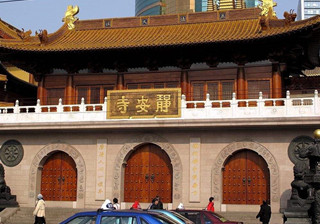- 86-15907880780
- contact@youngchinatravel.com
Jing'an Temple is situated at Nanjing Road (west). An island of serenity among  the bustling shops and malls, Jingan Temple has a history that stretches back almost two thousand years. It is a national key Temple of Buddhism in the Han Nationality's Region, as well as a national cultural heritage under special protection.
the bustling shops and malls, Jingan Temple has a history that stretches back almost two thousand years. It is a national key Temple of Buddhism in the Han Nationality's Region, as well as a national cultural heritage under special protection.
Built during the Three Kingdoms period in 247 AD, the temple was originally established, not here, but on the northern bank of the Suzhou River. It was first called Huduzhongyuan Temple, and later changed its name to Yongtaichan Temple during the Tang Dynasty. The temple's current name, Jingan Temple, was first used in 1008 AD — the first year of the reign of Northern Song Dynasty Emperor Xianfu. In 1216, during the Southern Song period, severe damage caused by the Suzhou River forced the relocation of the Jingan Temple to its current address.
During the Qing Dynasty, there was a period of time when all of the Buddhist temples in Southern China fell into serious decline. Unfortunately, Jingan Temple was no exception. Luckily, in 1741, during the reign of Emperor Qian Long, several officials assisted in Jingan Temple’s reconstruction, and expanded the temple by adding a fountain in the front and Baoen Yuan, the eastern courtyard. Head Monk, Master Dahai, carved a burned Song Dynasty gingko tree into the figures of 18 Buddhist saints and one of Skanda, the Buddhist temple's guardian spirit. All nineteen carvings were enshrined inside the temple and permanently preserved as temple treasures. Most of the temple was destroyed during the Taiping Rebellion, leaving behind only the solitary audience hall. Thanks to the great efforts of the abbot, Master Hefeng, Jingan temple was restored in 1880. In April 1881, the temple was rededicated during the Buddhist festival of "Bathing the Buddha". To commemorate the anniversary of this occasion, every year people come to the temple to burn incense and take part in what has become a lively and extraordinary temple fair.
After the World War Two, a new Tang-style temple entrance was built to the east of the original, and an ancient Indian pillar was erected on the side of the well wall of the fountain in front. This has become one of Jingan Temple's identifying structures. In 1953, temple abbot, Master Chisong built a tannic altar in the temple interior, reviving a custom that had long since been discontinued. Without a doubt, Jingan Temple has once again become a sacred shine for people around the world, remaining completely detached from the thriving city right outside its gates. In April of 2007, head monk, Master Taixu hosted the ribbon cutting at the new Jingan Temple Academy's opening ceremony. The crowd attending the ceremony included monks and layman alike, and totaled over ten thousand people, turning the ceremony into a grand occasion.
Now Jingan Temple is a Buddhist temple with grand halls and majestic  Buddhist statues. The main buildings includes Tianwang Hall, Daxiongbao Hall and Sansheng Hall and the assistant building involves Gongde Hall, Abbot's Room, Exhibition hall of Buddhist cultural relic, Xiangji Room, Monk's Room and Wing-room. In the center of the Tianwang Hall, People worship the Maitreya statue, and both sides of the hall, there are the Four Heavenly Guards who are standing tall and upright to guard die temple, b addition, there is the Shingon Mandala within the temple, including Peacock Mandala, 11umo Mandala, Shengtian Mandala, Zhutian Mandala and so on. With layer upon layer of temple halls and sanctuaries, the temple has also preserved the oldest stone tablet in Shanghai. Written by Song Emperor Zhaodun while he was still a crown prince, the tablet reads, "The sunlight reflects off the Yin River waters and returns to the land". Jingan Temple also a Ming Dynasty bell cast from three tons of copper in 1369.
Buddhist statues. The main buildings includes Tianwang Hall, Daxiongbao Hall and Sansheng Hall and the assistant building involves Gongde Hall, Abbot's Room, Exhibition hall of Buddhist cultural relic, Xiangji Room, Monk's Room and Wing-room. In the center of the Tianwang Hall, People worship the Maitreya statue, and both sides of the hall, there are the Four Heavenly Guards who are standing tall and upright to guard die temple, b addition, there is the Shingon Mandala within the temple, including Peacock Mandala, 11umo Mandala, Shengtian Mandala, Zhutian Mandala and so on. With layer upon layer of temple halls and sanctuaries, the temple has also preserved the oldest stone tablet in Shanghai. Written by Song Emperor Zhaodun while he was still a crown prince, the tablet reads, "The sunlight reflects off the Yin River waters and returns to the land". Jingan Temple also a Ming Dynasty bell cast from three tons of copper in 1369.
Exhibition hall collects hundreds of Buddhist cultural relics, and Jing'an Temple boasts the stone Buddhist statue caved in the Southern and Northern Dynasties, Dharma statue made of copper and silver in Ming Dynasty, and Amitabha statue made in Qing Dynasty and so on. In addition, published by Shanghai Pinjiajingshe from 1909 to 1913, the Pin Jia Tripitaka is collected in the Jing'an Temple, it is the first Tripitaka published with printing type in modern times.